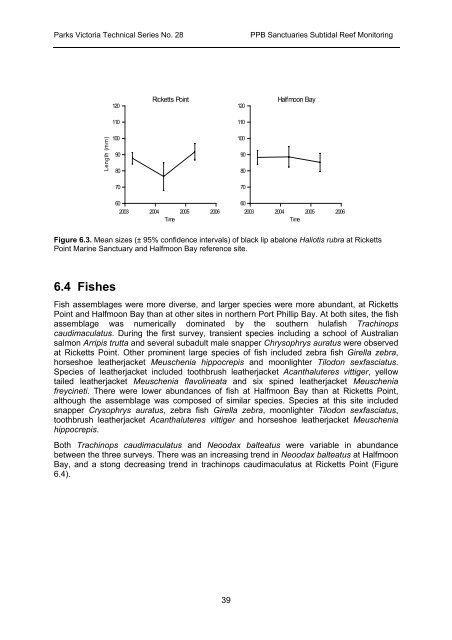Victorian Subtidal Reef Monitoring Program - Parks Victoria
Victorian Subtidal Reef Monitoring Program - Parks Victoria
Victorian Subtidal Reef Monitoring Program - Parks Victoria
Create successful ePaper yourself
Turn your PDF publications into a flip-book with our unique Google optimized e-Paper software.
<strong>Parks</strong> <strong>Victoria</strong> Technical Series No. 28PPB Sanctuaries <strong>Subtidal</strong> <strong>Reef</strong> <strong>Monitoring</strong>120Ricketts Point120Halfmoon Bay110110Length (mm)100908070602003 2004 2005 2006Time100908070602003 2004 2005 2006TimeFigure 6.3. Mean sizes (± 95% confidence intervals) of black lip abalone Haliotis rubra at RickettsPoint Marine Sanctuary and Halfmoon Bay reference site.6.4 FishesFish assemblages were more diverse, and larger species were more abundant, at RickettsPoint and Halfmoon Bay than at other sites in northern Port Phillip Bay. At both sites, the fishassemblage was numerically dominated by the southern hulafish Trachinopscaudimaculatus. During the first survey, transient species including a school of Australiansalmon Arripis trutta and several subadult male snapper Chrysophrys auratus were observedat Ricketts Point. Other prominent large species of fish included zebra fish Girella zebra,horseshoe leatherjacket Meuschenia hippocrepis and moonlighter Tilodon sexfasciatus.Species of leatherjacket included toothbrush leatherjacket Acanthaluteres vittiger, yellowtailed leatherjacket Meuschenia flavolineata and six spined leatherjacket Meuscheniafreycineti. There were lower abundances of fish at Halfmoon Bay than at Ricketts Point,although the assemblage was composed of similar species. Species at this site includedsnapper Crysophrys auratus, zebra fish Girella zebra, moonlighter Tilodon sexfasciatus,toothbrush leatherjacket Acanthaluteres vittiger and horseshoe leatherjacket Meuscheniahippocrepis.Both Trachinops caudimaculatus and Neoodax balteatus were variable in abundancebetween the three surveys. There was an increasing trend in Neoodax balteatus at HalfmoonBay, and a stong decreasing trend in trachinops caudimaculatus at Ricketts Point (Figure6.4).39
















